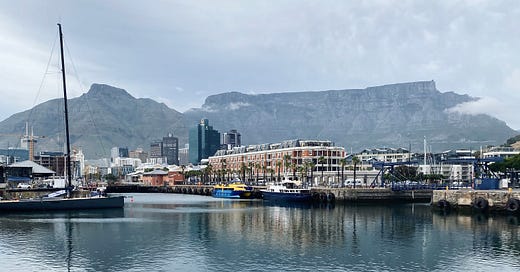Bridging the Gap: The Role of Coworking Spaces in the Digital Nomad Era
An exploration of how coworking spaces in tourist and nomad hot spots can better serve local communities.
When the cold weather began to set in last autumn, I jetted off to sunnier climes, spending three weeks travelling across Southeast Asia. The excursion was an exercise in working from anywhere, allowing me to balance my desire for travel with my responsibilities as a freelance content writer.
In those three weeks, I organised an in-person freelance community event, worked on clients’ personal brands (with the big time difference not stopping us from getting on calls and exchanging WhatsApp messages), and wrote several blog posts.
What made this possible were the coworking spaces around the region, offering affordable day passes, reliable internet connectivity, and the opportunity to meet other people in similar situations.
Often these spaces were independent coworking spaces. For those staying long-term in a region, like digital nomads, the bonus of these spaces is the focus on building a thriving community of like-minded people, who combine work and travel as part of their lifestyles.
Coworking for digital nomads
While traveling, I was in the perfect place to work on the content piece – the top 10 coworking spaces for digital nomads, researching some of the world’s most attractive nomad destinations and coworking spaces for nomads.
While typing this up, I sat next to a pool at 30 degrees, a view of the mountain temples of Chiang Mai just about visible in the distance. It was hard not to be totally on board with this lifestyle choice!
Chiang Mai is the region’s second most popular destination for digital nomads. The most popular is Bali, the island hosted over 4,000 digital nomads in 2024 alone. As I write in the article: “A combination of hot, sunny weather and low cost of living makes Southeast Asia the perfect nomad haven. From beautiful islands to lush rainforests, this region has it all.”
Another one of my coworking spot in Luang Prabang, Laos
Coworking operations in seasonal hotspots
Planning for my trip last summer, I looked at staying in coliving spaces with coworking facilities. However, many coworking hubs in Southeast Asia operate on a seasonal basis, opening their doors to everyone during peak tourist season while opening on demand in the low season.
This helps the business stay afloat, as the increasing costs to cover overheads, salaries, and utilities, aren’t feasible during low tourist periods. For example, The Social Club in Chiang Mai, a coliving and coworking space, only opens its coworking space doors to the public during the high season (November to March).
Likewise, when I was looking to work from a coworking space in Luang Prabang, Laos, I found a workspace called The Desk, which only opened on demand, and I emailed ahead to book in. Its founders, Chris and Saita, run multiple businesses in the area – it’s not unusual for coworking operators in these parts.
Their other business was a horse trekking stables and I couldn’t resist booking this activity too. One day I was coworking from their workspace, the next, I was out on the Laotian hills.
Coworking at The Desk, in Luang Prabang
The digital nomad visa scheme
This all sounds pretty fantastic, right? As a BBC article published last year states: “If all that is needed is a decent internet connection then why not set up in one of the world's most picturesque cities?”
Many have - there’s been a staggering 131% increase in the number of US nomads between 2019 and 2024.
In Europe, Budapest is fast becoming one of the world’s most attractive nomad hubs, ranking 9th most popular currently. Its affordability, fast internet speed, and thriving tech scene are only some reasons nomads flock to the Hungarian capital.
And I can’t list European nomad spots without mentioning Matthias Zeitler, founder of Coworking Bansko! Organiser of the annual Bansko Nomad Fest, Matthias is a community pillar at the helm of the workspace hub, where several sites sprawl across the mountainous Bulgarian town. He’s also building Coliving Semkovo.
Recently, some governments have introduced incentives such as digital nomad visas. For example, Portugal’s D8 digital nomad visa grants residency to nomads earning over €3,000 a month. Living in Portugal reduces tax on foreign income to 0%, with just 20% tax due on income earned in Portugal.
Croatia, Spain, and Malta have all introduced digital nomad visas too. Of course, a nomad visa isn’t for everyone and they’re not guaranteed unless you meet a certain income threshold, and your job complies with remote working, amongst other requirements.
The challenge of nomadism
But, while the positives of nomadism are plentiful, and the incentives there, becoming a digital nomad is a privilege, bringing many complexities associated with this booming lifestyle perk.
In her article, Confronting Global Gentrification: The Digital Nomad Dilemma, Lauren Razavi addresses how during lockdowns, Mexico’s open borders policy and the ease of doing quick visa runs (for an easy six-month extension) made the country an attractive hub for international nomads.
But, Razavi explains:
“In Tulum, chain link fences separate the luxury condominiums from the shanty towns where local cleaners, construction workers, and food vendors live. While in Playa del Carmen, upmarket resorts are situated within gated communities and armed security guards only permit locals to enter for work. In both places, signs and billboards advertise 0% finance for Americans and Canadians to purchase local properties and monetize them on Airbnb, as well as expedited immigration services for such investors.”
The widening gap between low and middle-income Mexicans, and digital nomads on high wages earning international currencies, leads to the gentrification of cities and displacement “at an alarming speed.” Razavi critiques a system that doesn’t benefit the local residents.
Likewise, a BBC article from April 2024 exposes a similar “digital nomad epidemic” in Capetown, where a nomad visa was introduced at the end of last year.
This piece introduces two sides of the argument. First, nomads typically relocate to the South African capital to escape unaffordable housing and living costs in their home countries. But at the same time, their earning potential is higher than living wages in the city. This pushes up house prices astronomically, causing local residents to be displaced from the city that they once called home.
Capetown, South Africa
What can the coworking industry do?
With demand for coworking spaces in these nomad hotspots increasing, can shared workspaces somehow bridge the gap to better serve nomads and locals?
Nomads and expats can often fail to integrate into a local culture, leading to a lack of cross-pollination within communities. With community being a core principle of coworking values, could workspaces operate as meeting points to facilitate workshops and upskilling sessions, knowledge sharing, and ideation exchange?
Workspace operators can consider whether their rates are truly affordable, and how they can provide better opportunities to serve local communities. Offering more affordable access and prioritising job opportunities for local talents – such as community managers, event organisers, or trainers – coworking spaces can become powerful catalysts for economic growth.
Partnerships with local organisations and enterprises could also bring fantastic opportunities to communities, such as new local-owned businesses that hugely contribute to the ecosystem.
With the number of digital nomads continuing to grow, the future of this lifestyle will depend on finding a balance between the needs of nomads and the communities. As cities and regions adjust to the influx of remote workers, coworking spaces will remain critical hubs – not just for work, but for creating collaboration and inclusivity.







